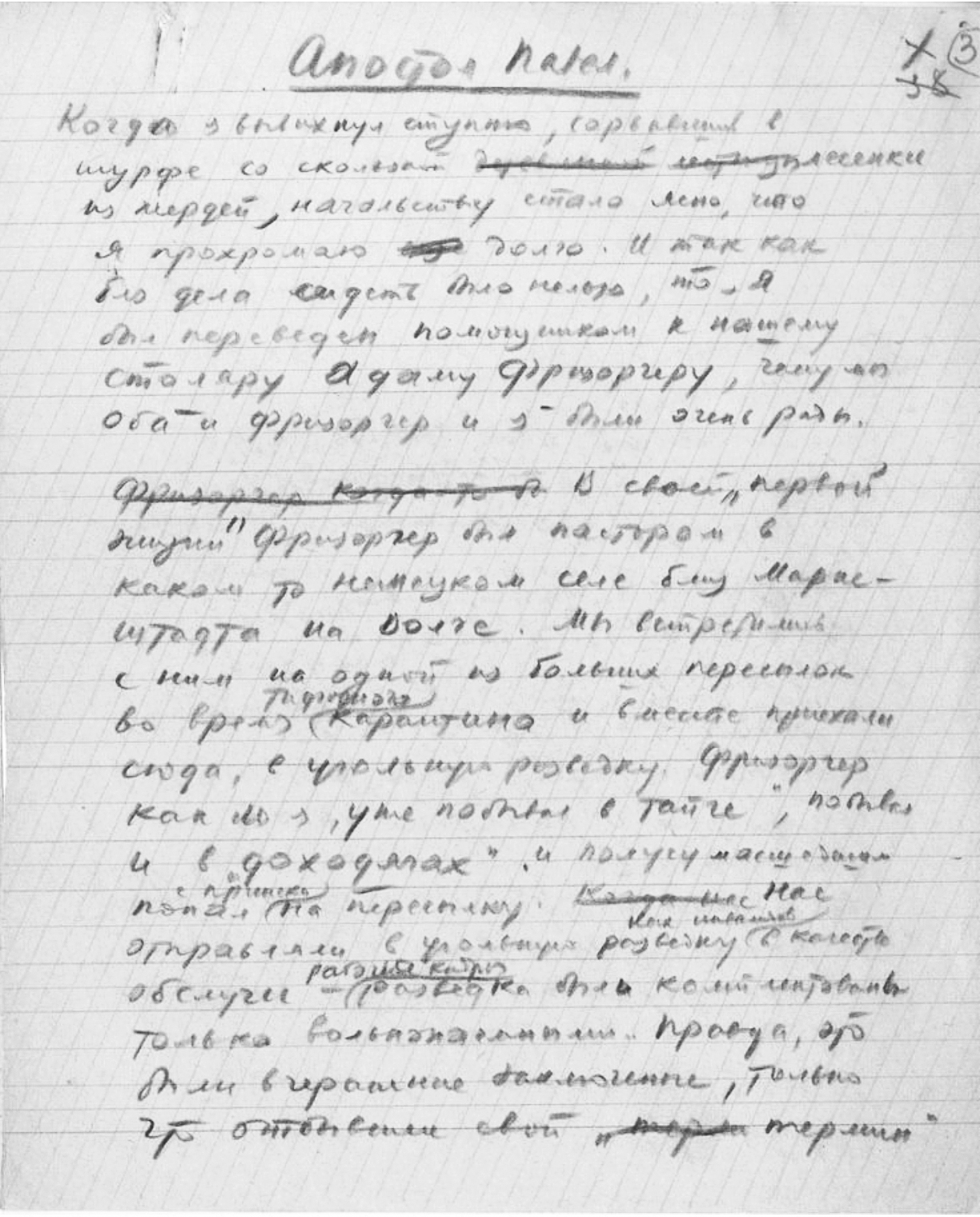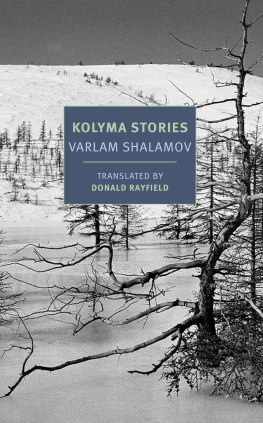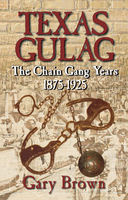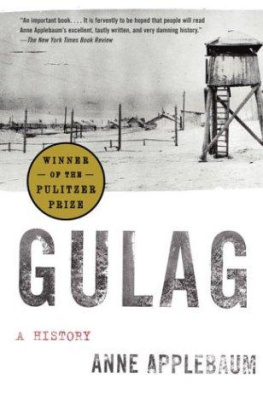
VARLAM SHALAMOV (19071982) was born in Vologda in western Russia to a Russian Orthodox priest and his wife. After being expelled from law school for his political beliefs, Shalamov worked as a journalist in Moscow. In 1929, he was arrested at an underground printshop and sentenced to three years hard labor in the Ural Mountains, where he met his first wife, Galina Gudz. The two returned to Moscow after Shalamovs release in 1931; they were married in 1934 and had a daughter, Elena, in 1935. Shalamov resumed work as a journalist and writer, publishing his first short story, The Three Deaths of Doctor Austino, in 1936. The following year, he was arrested again for counterrevolutionary activities and shipped to the Far Northeast of the Kolyma basin. Over the next fifteen years, he was moved from labor camp to labor camp; imprisoned many times for anti-Soviet propaganda; forced to mine gold and coal; quarantined for typhus; and, finally, assigned to work as a paramedic. Upon his release in 1951, he made his way back to Moscow where he divorced his wife and began writing what would become the Kolyma Stories. He also wrote many volumes of poetry, including Ognivo (Flint, 1961) and Moskovskiye oblaka (Moscow Clouds, 1972). Severely weakened by his years in the camps, in 1979 Shalamov was committed to a decrepit nursing home north of Moscow. In 1981, he was awarded the French PEN Clubs Liberty Prize; he died of pneumonia in 1982.
DONALD RAYFIELD is Emeritus Professor of Russian and Georgian at Queen Mary University of London. As well as books and articles on Russian literature (notably A Life of Anton Chekhov), he is the author of many articles on Georgian writers and of a history of Georgian literature. In 2012 he published Edge of Empires: A History of Georgia, which has recently come out in an expanded Russian edition, as have his Life of Chekhov and Stalin and His Hangmen. He was the chief editor of A Comprehensive Georgian-English Dictionary. He has translated several novels, including Hamid Ismailovs Devils Dance from the Uzbek, and Nikolai Gogols Dead Souls (an NYRB Classic).

A manuscript page from Shalamovs story The Apostle Paul
To Ira, my endless recollection, brought to a halt in The Left Bank
NOTES
INTRODUCTION
The Gold Medal appears in Volume Two.
Permafrost appears in Volume Two.
For example, torture.
The date of Shalamovs request for rehabilitation.
See the story The Green Prosecutor.
These contingents were special groups singled out for particular treatment.
See the story Berries.
Berlin: Matthes & Seitz, 2013.
BOOK ONE: KOLYMA STORIES
Osip Mandelstam.
Pine-needle extract is still used in Russian and Chinese medicine (as a source of vitamin C) to combat scurvy.
Kuznetsov means blacksmith.
This term (as sherri-brendi) hitherto only occurred in a poem by Osip Mandelstam, so the story must be read as a re-creation of the death of Mandelstam, who died on December 27, 1938, in a transit camp near Vladivostok.
The name given to an informal Russian association of fraudsters, operating in the early 1870s and the subject of several accounts, true and embroidered.
A thick cotton material, a substitute for leather.
A nineteenth-century poem about a railway laid over the bones of the laborers who built it.
A fashionable shopping street in central Moscow.
In 1947 Stalin personally awarded a prize for this novel, even though the prize committee had rejected it.
Russian ravioli, made with two sorts of meat, eaten in broth.
Soviet prisoners of war who agreed to fight under General Vlasov alongside the German army; they were mostly repatriated to the USSR in 1945 and 1946 and shot or sent to the camps.
In 1922 Herriot, a French senator with Soviet sympathies, had his gold watch stolen on a visit to the Hermitage; underworld figures recovered it. The story was told by the NKVD investigator and writer Lev Sheinin.
Sir Williams (pseudonym of Andrea de Felipone) is the ill-fated villain in novels, such as The Exploits of Rocambole, by the nineteenth-century French writer Ponson du Terrail.
Berzin, who by then had been shot, was the founder of the Kolyma forced-labor mining camps.
BOOK TWO: THE LEFT BANK
Leonid Ramzin, a professor of engineering and a star false witness, who was accused at a 1930 show trial, was rewarded for his testimony by being allowed to continue engineering work in prison, whereafter he was granted amnesty.
An anarchist terrorist who later became an ardent Stalinist.
Nestor Makhno, an anarchist leader in the Civil War in Ukraine.
Trotsky called Stalins concocted political trials of an unlikely assortment of opponents amalgams.
Latin for let us rejoice.
In fact, the Moscow Art Theater had existed since 1898.
Vitovt Putna (18931937) was a brilliant military commander during the Polish-Soviet war of 1920; he then became a military attach and was shot on June 12, 1937, during Stalins purge of senior army officers.
Stalins most trusted, longest-serving general and minister.
A hypnotist, reputed to have worked for the NKVD after 1929.
An agronomist and the vice president of the United States under Franklin D. Roosevelt, Wallace in June 1944 spent weeks in Magadan and Kolyma as a guest of the NKVD. He was fooled by the guards dressed in prison uniforms pretending to be well-fed, happy prisoners. Not until the 1950s did Wallace admit his gullibility.
Boris Savinkov, a leading Socialist Revolutionary, killed by the Soviet secret police in 1925.
In February 1905, Ivan Kaliayev, a Socialist Revolutionary, killed Grand Duke Sergei Aleksandrovich with a bomb; he had aborted a previous attempt to avoid killing the Grand Dukes wife and nephews.
Right SRs, unlike left SRs, had disavowed violent revolution.
Maria Spiridonova, a leading left SR, was shot on Stalins orders in 1941.
Prosh Proshian, a leading left SR, Peoples Commissariat for Post and Telegraph, died of typhus in 1918.
Grigori Gershuni, a Russian terrorist, died in 1908 of cancer, two years after escaping from prison by hiding in a barrel.
Four members of Peoples Will who were hung in 1881 for assassinating Tsar Alexander II.
Egor Sozonov committed suicide in prison in 1910 to avoid being flogged.
Lev Zilberberg, hanged in 1907 for assassinating the Petersburg mayor.
Vera Figner (18521942) and Nikolai Morozov (18541946), the two Peoples Will terrorists who died of natural causes.
Agasi Khandjian, the secretary of the Armenian Communist Party, was shot in 1936 by Beria without a trial, after a quarrel.
Mikhail Gots, a founder of the SR Party, died in 1906 after an operation to remove a spinal tumor.
No such book exists. Shalamov may be recalling Gustav Jaeckhs History of 1906.
Charles Masson, Mmoires secrets sur la Russie of 1802.
A mine winch rotated by several men pushing a wooden beam; called Egyptian because of the slave labor required.
Reminiscent of Don Quixote: Beauty in a modest woman is like fire at a distance or a sharp sword; the one does not burn, the other does not cut, those who do not come too near.
In 1826 Mikhail Bestuzhev, a naval officer, before his arrest devised a system of tapping the alphabet, anticipating Morse code. It has remained in use in Russian prisons.
That is, informs on you.








